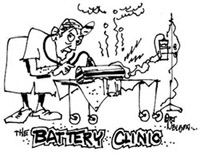The black wire syndrome is an occupance in battery packs (Ni-Cds) where the negative wire becomes corroded (turns from
shinny copper to blue-black). This is the result of either a shorted cell in the pack, the normal wearout failure mode of
Ni-Cds, or cell reversal when a pack is left under load for an extended period. The sealing mechanism of a Ni-Cd cell depends
to some degree on maintaining a potential across the seal interface. Once this potential goes to zero the cell undergoes what
is called creep leakage. With other cells in a pack at some potential above zero the leakage (electrolyte) is "driven"
along the negative lead. It can travel for some distance making the wire impossible to solder and at the same time greatly
reducing its ability to carry current and even worse, makes the wire somewhat brittle. A switch left on in a plane or transmitter
for several months can cause this creepage to go all the way to the switch itself, destroying the battery lead as well as
the switch harness. There is no cure. The effected lead, connector, switch harness must be replaced.
This leakage creep
takes time so periodic inspection of the packs, making sure that there are no shorted cells insures against the problem. The
cells should also be inspected for any evidence of white powder (electrolyte mixed with carbondioxide in the air to form potassium
carbonate). In humid conditions this can revert back to mobile electrolyte free to creep along the negative lead. Some "salting"
as this white powder is referred to, does not necessarily mean that the cell has leaked. There may have been some slight amount
of residual electrolyte left on the cell during the manufacturing process. This can be removed with simple household vinegar
and then washed with water after which it is dried by applying a little warmth from your heat gun..
C. Scholefield
8/29/96

